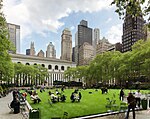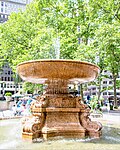Statue of William E. Dodge
1885 establishments in New York (state)1885 sculpturesBronze sculptures in ManhattanBryant ParkMonuments and memorials in Manhattan ... and 5 more
New York (state) sculpture stubsNew York City stubsOutdoor sculptures in ManhattanSculptures of men in New York CityStatues in New York City

William Earl Dodge is an outdoor bronze sculpture of William E. Dodge by John Quincy Adams Ward, located at Bryant Park in Manhattan, New York. It was cast in 1885 and dedicated on October 22 of that year.
Excerpt from the Wikipedia article Statue of William E. Dodge (License: CC BY-SA 3.0, Authors, Images).Statue of William E. Dodge
West 40th Street, New York Manhattan
Geographical coordinates (GPS) Address Website Nearby Places Show on map
Geographical coordinates (GPS)
| Latitude | Longitude |
|---|---|
| N 40.75409 ° | E -73.9833 ° |
Address
Bryant Park
West 40th Street
10018 New York, Manhattan
New York, United States
Open on Google Maps










